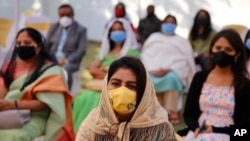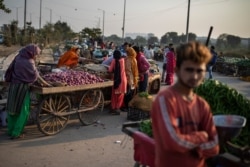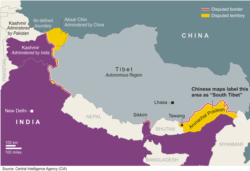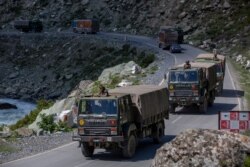India this year confronted its most serious economic and security challenges in decades as the COVID-19 pandemic plunged the country into a recession and a military standoff with China along their unresolved Himalayan borders derailed relations with its powerful neighbor.
One of the world’s strictest lockdowns imposed in March when it had just a few hundred cases did not stop the virus from wreaking havoc when the country began opening up. By the end of the year it was the second-worst hit nation, counting nearly 10 million cases.
But as millions lost jobs and hundreds of small businesses shut down, analysts warned that the economic scars inflicted by the pandemic ran deeper than the health crisis.
The first signals of widespread distress came in April, when India witnessed an unprecedented exodus of migrant labor stranded without jobs in cities, many walking hundreds of kilometers as all transport was abruptly shut down.
“Nowhere else in the world you saw millions and millions of people trudging to their villages on empty stomachs and without money,” said economist Arun Kumar in New Delhi. “The tragedy was that the unorganized sector was the hardest hit by the lockdown because many of these people have very little capital to survive a long shutdown.”
India has been the worst hit among major economies because nearly 90% of its workforce is sustained by the country’s vast informal sector. The economy is forecast to shrink by some 9% this year, its worst recession in four decades.
The Center for Monitoring Indian Economy estimated that some 120 million jobs were lost from April to June. While many came back as the government began easing restrictions to kickstart the economy, millions were still struggling to find work or restore livelihoods at the end of the year.
Among those fighting for survival were tens of thousands of street vendors who saw their business decimated by the pandemic.
Ranga Shalivan restarted his two small roadside stalls selling a popular Indian savory and sweet dumpling in July in the southern city of Hyderabad. For months he saw few customers, but he has seen some revival in recent weeks.
“It’s slightly better now, but I am still making only about half the money that I used to. It has been very hard,” he said.
The government has announced two stimulus packages, but Finance Minister Nirmala Sitharaman told industry leaders that no amount of government intervention would be enough to deal with the crisis triggered by the pandemic.
But by the end of the year declining numbers of new COVID-19 infections and hopes of rolling out a vaccine within weeks offered hope that the worst may be over as India gets a grip on the health emergency.
“There are signs of revival, but it must be sustained,” said Sitharaman.
Economist Kumar, however, warned that significant revival will be a long haul for the world’s second most populous country.
“Employment is down, investment is down, consumer confidence is down and government resources are meager. Even in 2021 we will not recover back to the position in 2019.”
As the government grappled with the pandemic, India stared at another crisis on its borders with China in the northern state of Ladakh, where it said in May that Chinese troops had intruded into its side of the unmarked border.
In June, a bloody clash killed 20 Indian soldiers and led to a standoff that shows no signs of a resolution despite multiple rounds of negotiations.
Thousands of troops from both countries are now posted on icy Himalayan ridges in subzero temperatures. It is the biggest military deployment by the two rivals in decades.
“The relationship, very frankly, this year has been very significantly damaged,” Foreign Minister Subrahmanyam Jaishankar said, speaking at a virtual conference with Australia’s Lowy Institute earlier this month.
“We are today probably at the most difficult phase of our relationship with China, certainly in the last 30 to 40 years, you could argue even more.”
Analysts do not expect any early end to the crisis as both countries spar over their differing perceptions of the border.
“There is a belated recognition in India that China, not Pakistan, is our only and biggest threat,” said Bharat Karnad, a strategic affairs analyst at New Delhi’s Center for Policy Research. He warned the situation could worsen.
“I think there are going to be more sustained hostilities on the China border next year in spring when the snows melt,” he said.
Prime Minister Narendra Modi also faced some of his biggest domestic challenges since taking power six years ago. Following widespread protests in the aftermath of a new citizenship law that critics say discriminates against Muslims, the Indian capital was wracked by its worst communal riots in decades in February, killing more than 50 people. In December, tens of thousands of farmers angered by agriculture reforms that liberalize rules for sale of farm produce camped on the outskirts of New Delhi demanding the laws be scrapped over worries that their incomes will be hurt.
Analysts say while the pandemic tested nations worldwide, the challenges facing India could make the road to recovery longer and tougher.











